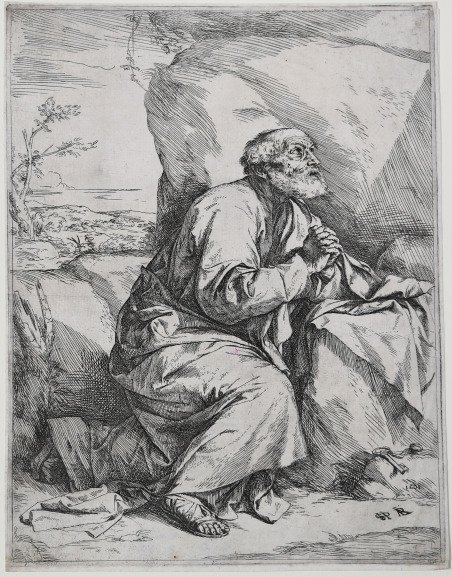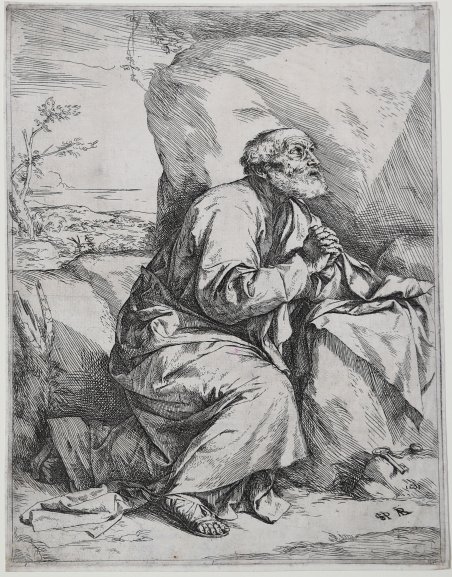Détails
Graveurs
RIBERA detto "lo Spagnoletto" Jusepe di (Jatiba circa 1590 -, Napoli 1652)
Description
Acquaforte e bulino, monogrammata e datata in lastra in basso a destra. Esemplare nel secondo stato, di due, con il monogramma di Fransz van Wyngaerde aggiunto in basso.Splendida prova, impressa su carta vergata coeva, sottili margini oltre l’impronta del rame, in ottimo stato di conservazione. Questa incisione ha la stessa data della prima composizione di "San Girolamo penitente che ascolta la Tromba del Giudizio", mentre il suo monogramma si trova nella stessa posizione. Come il San Girolamo datato, anche il San Pietro corrisponde a uno dei dipinti di Ribera nella Collegiata di Osuna, per il quale esiste anche un disegno correlato nella stessa direzione della stampa (collezione privata, Parigi). Ci sono sottili variazioni tra le immagini di San Pietro: soprattutto, Ribera ha cambiato la disposizione delle gambe del santo e il drappeggio sua veste e ha creato due diversi sfondi paesaggistici. La stampa segue cronologicamente il dipinto, suggerendo che le incisioni erano destinate a divulgare la produzione pittorica di Ribera, in questo caso una delle sue prime grandi commissioni a Napoli, ovvero il viceré spagnolo.Il ritratto di San Pietro penitente in un paesaggio deserto è uno dei primi argomenti in cui Ribera presenta figure sacre che si allontanano da tutte le cose mondane. Per l'apostolo, quest’atto di rinuncia fu la risposta alla predicazione di Cristo sulla necessità di abbandonare tutti i beni, a cui Pietro rispose "Ecco, abbiamo abbandonato tutto e ti abbiamo seguito" (Matteo 19:27). //// Etching with some engraving, signed with a monogram and dated 1621. Example in the second state, of two, with the letter “F, V, WYN” in basso (monogramma dell’editore Fransz van Wyngaerde).Magnificent example printed on contemporary laid paper, thin margins, in excellent condition.This etching bears the same date as the first composition of “Saint Jerome Hearing the Trumpet”, whereas its monogram is in the pointendly perspectival arrangement of the second. Like the dated Saint Jerome, the Saint Peter corresponds to one of the paintings by Ribera in the Colegiata of Osuna, for which there is also a related drawing n the same direction as the print (private collection, Paris). There are subtle variations between the Saint Peter images: above all, Ribera changed the disposition of the saint’s legs and the fall of his robe and offered two different landscape backgrounds. The print succeeded the painting in the date, suggesting again than the etchings were meant to disseminate knowledge of Ribera’s art, in this case one of his first great commissions in Naples, which significantly, was for the Spanish viceroy. The portrayal of Saint Peter doing penance in the wild is one of a number of early subjects in which Ribera presents sacred figures casting off all wordly things. For the apostle, this act of renunciation occurred in response to Christ’s preaching the necessity of abandoning all possessions, to which Peter replied “Behold, we have forsaken all, and followed thee” (Matt. 19:27). Pérez Sánchez – Spinosa (1992), n. 76; Bartsch, 7; Brown, 6; TIB 44.257.7; Salamon, n. 8; Bayer, 375.3.6.


Découvrez comment utiliser
Découvrez comment utiliser

